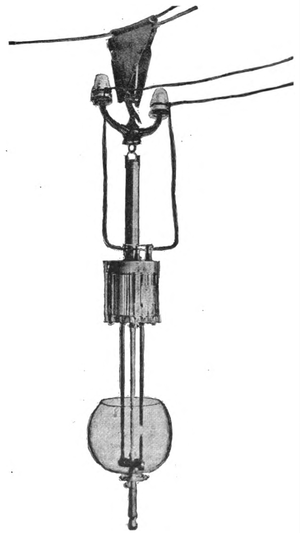[Trade Journal]
Publication: The Electrical Engineer
New York, NY, United States
vol. 10, no. 120, p. 190, col. 1-2
THE "FOREST" LAMP HANGER.
WHERE arc lamps are required to light outdoor or large interior space it is necessary to provide means for lowering them for cleaning and trimming, and in the past frequent trouble has arisen, and in some instances loss has been incurred, by the breaking or malicious cutting of the rope by which the lamp is suspended. To avoid this the Forest City Electric Works, of Cleveland, O., has recently brought out a novel lamp hanger which is illustrated in the accompanying engraving. As will be seen, the lamp is entirely supported by a hook on the line-wire supporting frame, which engages with a steel pin in the hood, thus taking all strain off the raising and lowering cord. This cord is not in use except when raising or lowering, and will, therefore, last much longer than when used to support the lamp. Cutting or untying this cord maliciously cannot drop the lamp, as, to disengage it from the hood, the lamp must be raised about six inches by the cord.
 |
| The "Forest" Lamp Hanger. |
When used to support a lamp over a street, the sheet steel hood is supported by a cross wire or cable and held in position by as mall wire or cord running to the pole. This allows of placing a lamp readily at any point over the street, and if it is desired to trim the lamp at one side of the street, as in the case of wires interfering, the position cord can be released and the raising and lowering cord will draw the entire hanger to one side of the street and release the lamp, which will then come straight down; and when trimmed it can again be pulled into engagement with the hood. The entire hanger with the lamp is then drawn along the cross wire to its proper position over the street.
By the construction adopted the lamp is also entirely insulated from the hanger and no strain whatever is brought on the lamp connections.
